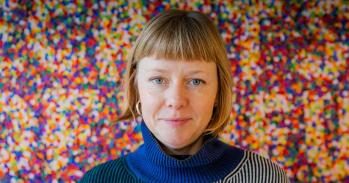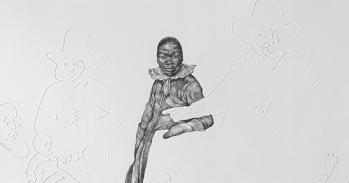
A new book by Professor Emma Wilson from the Faculty of Modern and Medieval Languages looks at how death is addressed through modern artworks based in visual media.
A new book by Professor Emma Wilson from the Faculty of Modern and Medieval Languages looks at how death is addressed through modern artworks based in visual media.
Art and its creation can be used to organise experience, the editing process allowing a sense of control in the face of brute, annihilating emotions.
Professor Emma Wilson
You don’t see her slip away, even though you are watching. A woman lies motionless in bed for 13 minutes, attended at intervals by nurses and her daughter – the artist Sophie Calle. Without these intrusions you might think you were looking at a still photograph. By the end of the film clip the woman has moved from life to death, but the point at which she dies remains invisible.
The clip is part of an art installation by Calle called You Couldn’t Capture Death, which is one of the contemporary artworks explored by Professor Emma Wilson from the Department of French in her new book Love, Mortality and the Moving Image. In the book, Wilson’s research involves moving image artists who are working with the space between life and death in a variety of ways – from home movies to photographic collages.
Wilson, who is also Course Director of the University’s MPhil in Screen Media and Cultures, examines the way different artists use both moving and still images to generate works as a coping mechanism for the emotional wrench that comes with the death of loved ones – and how we use visual media to see the dead as living, helping to manage the pain of loss.
“I’m interested in artists who are using their own intimate experiences to test how far a moving image artwork can offer recall of the deceased as still responsive,” said Wilson. “Art and its creation can be used to organise experience, the editing process allowing a sense of control in the face of brute, annihilating emotions.”
“I wanted to investigate moves from family acts of mourning to more public acts – the instigation of dialogue around death through moving image displays. In the case of Calle, the installation was a space that could be entered, opening the private experience up to other views and opinions.”
Wrapping, soothing, holding
Calle’s controversial installation contained details of the last book her mother read, her last trip to the coast and the inscription she wanted on her gravestone. A sense of the active planning for death that mother and daughter went through becomes part of the artwork. In this way, aspects of these artworks could be seen as ‘palliative’, providing a framework to assist with preparation for eternal separation.
In health care terms, palliative refers to ‘end of life’ care in which treatment protocols are established and the emphasis is on well-being and dignity as an individual prepares to conclude their life. Artworks like Calle’s can be seen to feed into this ethos, regarding death as a natural process that to an extent may be planned for.
Palliative derives from the Latin word ‘palliare’, meaning ‘to cloak’. Moving image art can contribute to this ‘cloaking’ in a number of ways. Cloaking can be allied with covering, enclosing, wrapping, soothing and holding. One of the works that Wilson gives a close reading of in the book strives for this embracing of a dying loved one through moving and still images – both commemorating and ‘cloaking’ them with the camera.
In her work Jacquot de Nantes, the filmmaker Agnès Varda interposes still images of herself and her husband Jacques Demy with moving film footage she took of him during the last months of his life. They knew Demy was dying, and Varda wanted to build a collage of her husband by overlaying different forms of visual tribute.
Varda created a photographic inventory of Demy as he existed – close-ups of his hair, skin, eyes and so on – and blended it with reconstructions of Demy’s childhood and extracts from his films to create a sensory impression of the person, the idea of the palliative seen in the attention of the camera to the body and the subjectivity of the person facing death – the same type of respect and tenderness.
The use of photography for direct commemoration that addresses death without flinching dates back to the 19th century, when common memorial practices included mortuary photography, the creation of daguerreotypes depicting the bodies of loved ones as if they are sleeping. For many people, the only pictorial record of their existence came when they had ceased to exist.
Hidden memory
Some argue that photography innately carries the reminder of death by ‘stilling’ a person – capturing a moment that will never be again. “There is a range of theory around this subject. The theorist Roland Barthes tells us that mortality is inherent in all photography, it creates a ‘temporal slip’ that draws attention to the emotion frozen in time,” said Wilson. “The moving image as a medium however can present the subject as living by depicting action – so that boundaries between living and dead are, if only in illusory form, disturbed.”
Bringing the dead ‘to life’ as it were through moving images is also addressed in the book’s analysis of Alina Marazzi’s film For One More Hour With You, in which the filmmaker reconstructs a vision of her mother through home movies and family photos. Marazzi’s mother committed suicide when the filmmaker was a young child, and Wilson explores how Marazzi creates a version of her mother, and develops a relationship with a woman she barely knew through the imagery.
“Home movies have been used in acts of mourning since the earliest available cameras,” explained Wilson. “In this work, Marazzi both creates and seeks the kick of hidden memory. As this was recovered footage it gives the illusion of a fresh glance of the dead still living, allowing her to address a part of her past previously uncharted.”
“I use Marazzi’s film to examine representations of childhood memory in moving images, and how it can be a conduit for emotion, as the filmmaker is introduced through film to her mother as a child, and how this relates to memories of her mother from her own childhood.”
The camera can be seen to allow access to the dead as living, or to the trauma of a loved one dying – Calle has said that having the camera in her mother’s room as she died was her way of being there in every respect that she could. But the camera can also create distance, reflecting and acknowledging the fact that death is ungraspable.
Alternative narratives
In palliative health care, thought is given to pathways and the stages that one faces. For Wilson, artists exploring this area can offer opportunities to imagine a variety of journeys through the extreme emotions involved in losing people to death.
“It’s not about finding a programmatic way of coping through art, but looking at how this kind of work can offer alternative narratives of death – by inviting people to share an example of how one person managed the loss of a loved one.”
Visually invoking and describing the dead will continue to be reinterpreted as technologies progress. Today, the images of those we’ve lost linger in the photo indexes of our smartphones and Facebook pages – testament to the power of the image, moving or otherwise, to prolong the illusion of a living presence, at the same time as it embodies the fleeting nature of all life, by trapping forever a moment never to be recaptured.
Love, Mortality and the Moving Image by Emma Wilson is available from Palgrave Macmillan.
This work is licensed under a Creative Commons Licence. If you use this content on your site please link back to this page.





